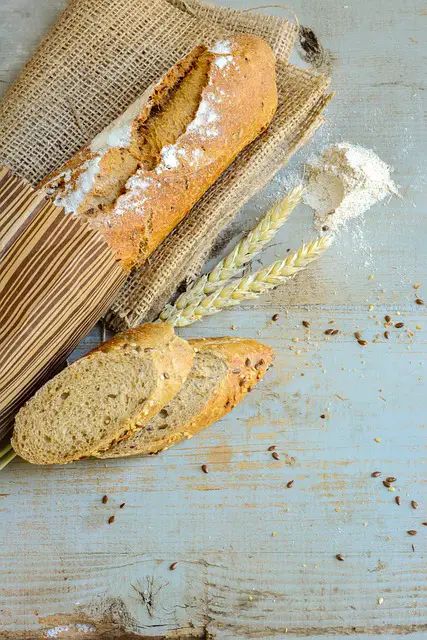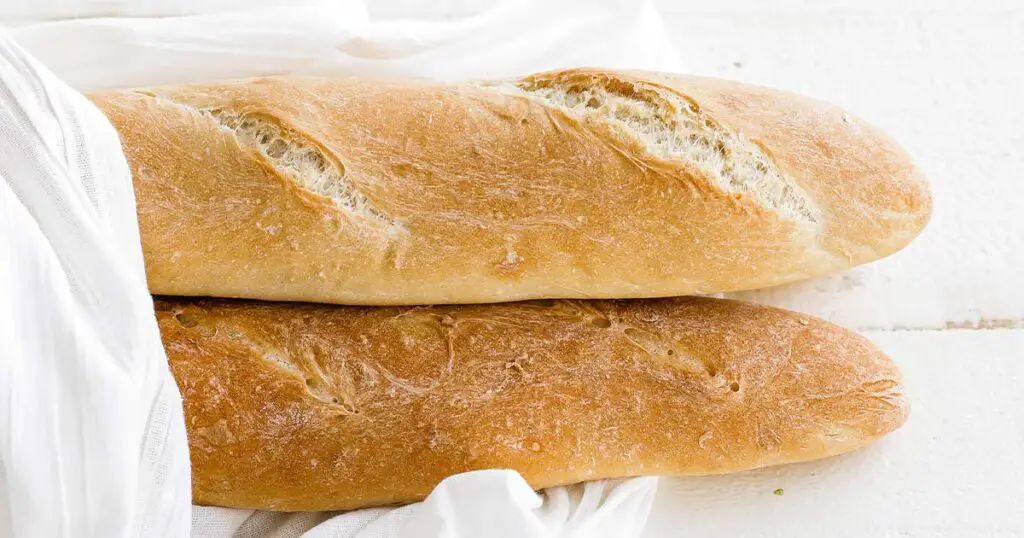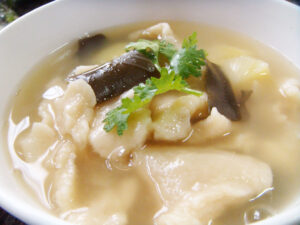Artisan French bread, with its crisp crust, soft, airy interior, and rich flavor, is a timeless classic that delights the senses and brings a touch of French cuisine to any table. Making authentic French bread at home can be a rewarding endeavor, allowing you to experience the magic of transforming simple ingredients into a masterpiece of texture and taste. This article will guide you through a basic yet versatile Artisan French Bread recipe, ideal for bakers of all levels who wish to master the art of French bread making.
Ingredients
4 cups (480g) of all-purpose flour, plus extra for dusting
1 ½ teaspoons (7g) of salt
1 ¼ teaspoons (4g) of instant yeast
1 ⅔ cups (395ml) of lukewarm water
Equipment
Large mixing bowl
Dough scraper or spatula
Baking stone or a heavy baking sheet
Parchment paper (optional)
Sharp knife or lame (a tool for scoring dough)
Spray bottle with water (for creating steam)
Instructions
Mixing the Dough
In a large mixing bowl, combine the flour, salt, and instant yeast. Stir to mix thoroughly.
Gradually add the lukewarm water to the dry ingredients while stirring with a wooden spoon or your hand until a shaggy dough forms. Ensure all the flour is hydrated.
Kneading
Turn the dough out onto a lightly floured surface.
Knead the dough for about 10 minutes, or until it becomes smooth and elastic. You might need to add a bit more flour if the dough is too sticky, but try to add as little as possible to keep the dough soft.
First Rise
Place the kneaded dough in a clean, lightly oiled bowl. Cover it with a damp cloth or plastic wrap.
Let the dough rise at room temperature until it doubles in size, about 1 to 2 hours, depending on the warmth of your kitchen.
Shaping
Gently deflate the dough on a lightly floured surface.
Shape the dough into a long loaf or baguette by folding it over onto itself and rolling gently with your hands.
Place the shaped loaf onto a baking sheet lined with parchment paper or a lightly floured peel if using a baking stone.
Second Rise
Cover the shaped dough loosely with a damp cloth and let it rise again until it puffs up slightly, about 45 minutes to 1 hour.
Preparing the Oven
Preheat the oven to 475°F (245°C) at least 30 minutes before baking. If using a baking stone, place it in the oven now to preheat as well.
Place an empty metal baking pan on the bottom rack of the oven for creating steam later.

Scoring and Baking
Just before baking, lightly dust the top of the loaf with flour and make several diagonal slashes across the top of the loaf with a sharp knife or lame.
Transfer the dough (on the parchment paper if used) directly onto the preheated baking stone or baking sheet.
Pour a cup of hot water into the preheated metal pan to create steam and close the oven door immediately.
Bake for about 25 to 30 minutes, or until the loaf is golden brown and sounds hollow when tapped on the bottom.
Cooling
Remove the bread from the oven and place it on a wire rack to cool for at least an hour before slicing.
This waiting period allows the crust to develop fully and the interior to set.
Making Artisan French Bread at home is a simple pleasure that yields delicious results. This recipe provides a foundation for exploring the art of French bread making, allowing for variations and adjustments to suit your taste and preferences. Whether served alongside a hearty stew, topped with your favorite cheeses and charcuterie, or simply enjoyed with a dab of butter, homemade French bread brings a taste of France to your kitchen and an undeniable joy to those who partake in its creation and consumption.
FAQ: Artisan French Bread
Can I use bread flour instead of all-purpose flour?
Yes, you can use bread flour instead of all-purpose flour. Bread flour has a higher protein content, which will result in a chewier texture and might slightly enhance the bread’s rise. The substitution should not significantly alter the recipe, but you may notice a slight difference in texture and flavor.
My dough didn’t double in size during the first rise. What went wrong?
There could be a few reasons why your dough didn’t rise properly. The most common reasons include the room temperature being too low, the yeast being old or inactive, or the dough being too dry. Ensure your yeast is fresh and active, the room is at a comfortable warm temperature, and the dough is properly hydrated.
Can I make this bread without a baking stone?
Yes, you can make this bread without a baking stone. A baking stone helps to evenly distribute heat and replicate a bread oven’s environment, but you can achieve good results with a heavy baking sheet as well. Just make sure to preheat the baking sheet in the oven before placing your dough on it to bake.
How do I store leftover bread to keep it fresh?
Artisan French bread is best enjoyed the day it is baked, but you can store leftovers for a few days. Wrap the bread in a clean, dry cloth and store it in a bread box or paper bag at room temperature. Avoid plastic bags, which can make the crust soft. For longer storage, slice and freeze the bread in an airtight container or freezer bag.
Why do I need to create steam in the oven?
Creating steam in the oven during the initial phase of baking helps in developing a crispy, shiny crust. The steam allows the surface of the dough to remain flexible longer, enabling the bread to expand and rise better before the crust hardens.
Can I add ingredients like olives, herbs, or cheese to this recipe?
Yes, you can customize this basic French bread recipe by adding ingredients like olives, herbs, cheese, or sun-dried tomatoes. Add these ingredients during the kneading stage to distribute them evenly throughout the dough. Keep in mind that wet ingredients may slightly alter the dough’s hydration, so adjust accordingly.
How can I achieve a more sour flavor, similar to sourdough bread?
To achieve a more sour flavor without making a true sourdough, you can try using a pre-ferment like a poolish or biga. These are mixtures of flour, water, and a small amount of yeast that ferment for several hours or overnight before being added to the final dough. This process can help develop more complex flavors in the bread.
The crust of my bread is too thick/hard. How can I adjust that?
A thick or hard crust can be the result of baking the bread too long or at too high a temperature. To achieve a thinner, softer crust, you can try reducing the oven temperature slightly and shortening the baking time. Additionally, wrapping the bread in a clean cloth while it cools can help soften the crust.
Can I make this bread in a bread machine?
While this recipe is designed for traditional baking methods, you can mix and knead the dough in a bread machine on the dough setting. However, for shaping, rising, and baking, follow the instructions for oven baking to achieve the characteristic artisan bread qualities.
How do I know when the bread is perfectly baked?
The bread is perfectly baked when it has a golden-brown crust, sounds hollow when tapped on the bottom, and reaches an internal temperature of about 190°F to 210°F (88°C to 99°C). Using an instant-read thermometer is a reliable way to check for doneness.




